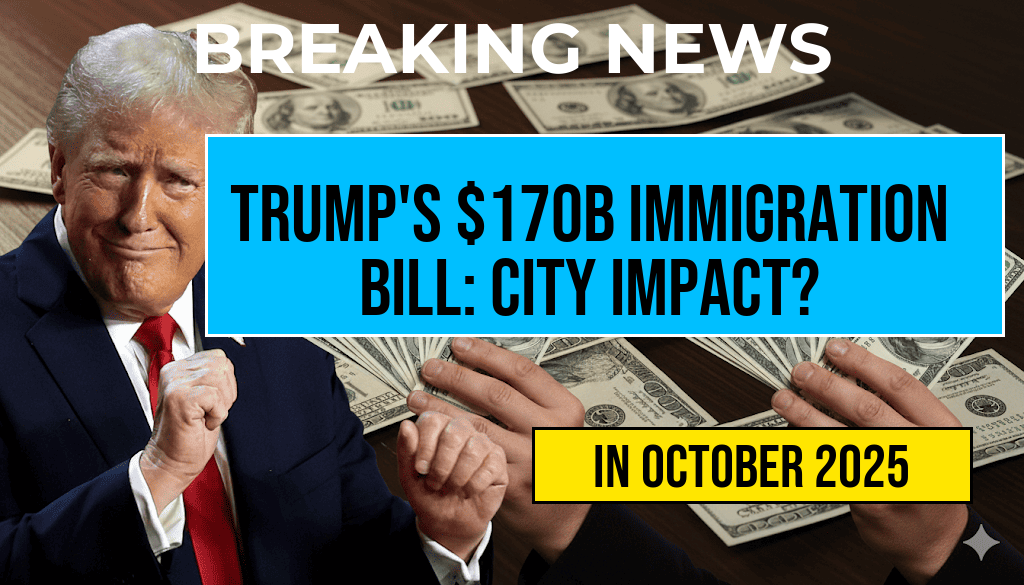Former President Donald Trump has unveiled an ambitious $170 billion immigration reform bill aimed at reshaping the U.S. immigration system and promoting economic growth. The proposal, which is set to be a cornerstone of Trump’s platform as he campaigns for the 2024 presidential election, highlights key areas such as border security, employment opportunities, and pathways to citizenship. With significant investments allocated to various sectors, including education and healthcare, the bill seeks to address longstanding concerns about immigration while potentially benefiting local economies across the nation. As cities brace for the implications of this legislation, many are left wondering how their communities will be affected and whether they stand to gain from the proposed changes.
The Key Components of the Proposed Bill
Trump’s immigration bill encompasses a range of initiatives designed to enhance national security while fostering economic opportunities. Below are the major components:
- Border Security Enhancements: The bill proposes increased funding for border patrol and surveillance technology to combat illegal immigration.
- Work Visa Expansion: A significant increase in work visas aimed at filling labor shortages in critical industries such as agriculture, construction, and technology.
- Pathways to Citizenship: The introduction of streamlined pathways for undocumented immigrants who meet certain criteria, including employment history and community contributions.
- Investment in Local Economies: A dedicated fund to support local governments in infrastructure development, education, and healthcare services driven by population growth.
Potential Benefits for Cities
Many cities across the United States may experience both immediate and long-term benefits from this proposed immigration reform. Here are several ways in which local economies and communities could thrive:
- Labor Market Boost: By increasing the number of work visas, industries facing labor shortages can fill crucial positions, leading to enhanced productivity.
- Economic Growth: Increased immigration could stimulate local economies through consumer spending and the establishment of new businesses.
- Cultural Enrichment: A diverse population can enhance cultural vibrancy, promoting innovation and creativity within communities.
Concerns and Criticisms
While many view Trump’s proposal as a positive step towards immigration reform, others raise concerns regarding its potential implications. Critics argue that:
- Community Strain: Rapid population growth may overwhelm local resources, including schools and healthcare systems.
- Economic Disparities: The potential for economic growth may not be evenly distributed, leading to increased inequalities within cities.
City-Specific Impacts
As the proposal moves forward, different cities may experience varying impacts based on their unique demographics and economic conditions. For example:
| City | Potential Benefit | Challenges |
|---|---|---|
| New York | Increased workforce in tech and service sectors | Pressure on housing and public services |
| Los Angeles | Boost to entertainment and agriculture industries | Traffic congestion and environmental concerns |
| Houston | Support for construction and energy sectors | Need for infrastructure upgrades |
Conclusion: The Road Ahead
The introduction of Trump’s $170 billion immigration bill could signal a significant shift in U.S. immigration policy. As cities assess the potential benefits and challenges, local leaders, businesses, and residents will need to engage in discussions about how to best prepare for the changes ahead. Stakeholders are encouraged to stay informed and actively participate in shaping the future of their communities as this legislation unfolds. For more information on immigration policies, visit Wikipedia or explore insights from Forbes.
Frequently Asked Questions
What is the main focus of Trump’s proposed $170 billion immigration bill?
The main focus of Trump’s proposed $170 billion immigration bill is to reform the current immigration system, aiming to enhance border security and streamline the process for legal immigration.
How will the immigration bill impact cities across the United States?
The immigration bill is expected to provide significant funding to various cities, potentially improving local economies and resource allocation as communities adapt to changes in immigration policies.
What specific benefits could cities receive from the proposed funding?
Cities could benefit from the proposed funding in various ways, including increased resources for public services, infrastructure improvements, and economic development initiatives aimed at integrating new immigrants.
Are there any criticisms of Trump’s immigration bill?
Yes, there are criticisms regarding the bill’s potential effectiveness and the impact it may have on undocumented immigrants as well as concerns about prioritizing certain groups over others in the immigration process.
When is the proposed immigration bill expected to be discussed or voted on?
The timeline for discussion or voting on the proposed immigration bill is currently unclear, but it is anticipated that it will be addressed in upcoming legislative sessions as part of broader immigration reform efforts.






